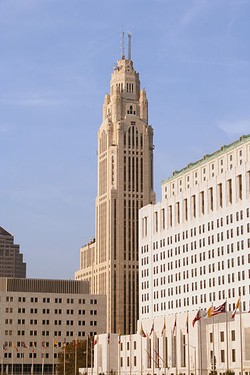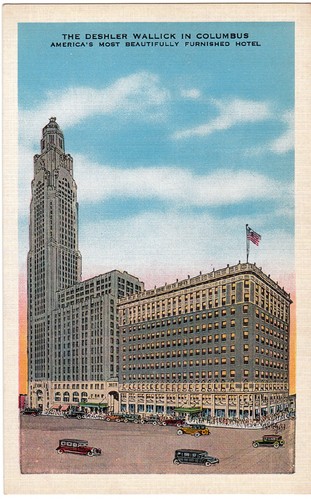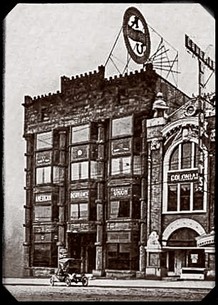LeVeque Tower
Introduction
Text-to-speech Audio
Images
Originally, the building's exterior featured a large number of sculptures. However, for legal and safety reasons much of it had to be removed because the terra-cotta began to crumble and fall to the street.

Upon its completion, two wings of the building served as a ballroom and 600-room addition for the Deshler-Wallick Hotel. This was one of the largest largest hotels in the world. It was demolished in 1970.

The original American Insurance Union building. The AIU was incorporated by businessman and politician John J. Lentz.

Backstory and Context
Text-to-speech Audio
The LeVeque Tower was originally constructed as the American Insurance Union Citadel. The groundbreaking on the new tower, which would replace the AIU’s previous four-story building on the same site, was held in 1924. Work was completed three years later. At a height of 555.5 feet, the tower became the fifth tallest building in the world, beating out the Washington Monument by 3/8 of an inch (as opposed to the previously thought six inches). It remained the tallest building in Columbus until the Rhodes State Office Tower was built in 1973.
The tower is extremely stable because the foundation goes all the way down to bedrock. C. Howard Crane devised a system derived from the method used to build the foundations for the towers of the Brooklyn Bridge. Caissons were sunk into the ground and workers dug out the dirt from inside their pressurized walls. This method was necessary due to the tower's proximity to the Scioto River which meant groundwater was only a few yards below the surface. This method was, however, very costly. Both from the standpoint that the equipment and power needed to run it (air compressors, decompressors) but also because working in a pressurized environment is very taxing on the workers. It was also time-consuming to get workers ready to work and they also had to go through a process of depressurization to prevent decompression sickness. All said, some workers would only spend 30 minutes actually digging before heading back up to the surface. The foundation resulted in the longest leg of the building process.
The AIU Citadel, or just “the Citadel,” cost not only $8 million but also five lives. One man fell from the steel framing. Four others died during the construction of the foundation when a pocket of noxious gas was opened during digging. The gas overwhelmed the workers, and they fell into the hole of the foundation.
Partly because of the expense of the new building, the AIU went bankrupt in 1937. In 1945, the building was sold to a group led by Leslie LeVeque of Columbus and John Lincoln of Cleveland (founder of Lincoln Electric). They then changed the name to the Lincoln-LeVeque Tower. LeVeque would later come to fame for hiring engineers to develop an automatic pin-setting machine for bowling. After the deaths of both Lincoln and LeVeque, the edifice was added to the National Register of Historic Places in 1975. Two years later, the name was officially changed to the LeVeque Tower.
Cite This Entry
Tanner, Michael, Joanne A. Nelson , and Emily Brammer. "LeVeque Tower." Clio: Your Guide to History. September 28, 2018. Accessed January 9, 2025. https://theclio.com/tour/560/3
Sources
Rose, Marla Matzer. LeVeque Tower showing fruits of $27 million restoration. Columbus Dispatch. August 27, 2016. Accessed September 28, 2018. http://www.dispatch.com/content/stories/business/2016/08/28/1-leveque-tower-showing-fruits-of-27-million-restoration.html.


